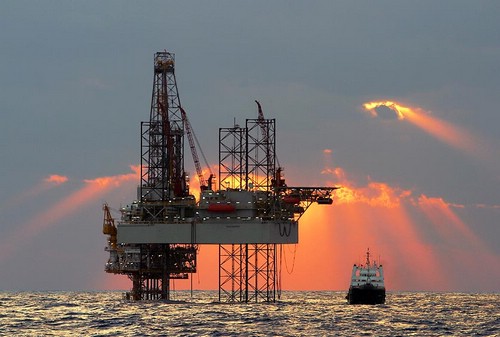Institute Bulk Oil Clauses 1983, and are appropriate for shipments of oils, crude, refined and vegetable.
The first part of the Clause follows the same perils as those detailed in the corresponding section in the standard “B” clauses. However, whereas the standard clauses refer to loss or damage reasonably attributable to those perils, for obvious reasons the Bulk Oil Clauses refer to loss of, or contamination of, the subject-matter insured.
Parts two and three of the Risks Clause differ substantially from the Institute Cargo Clauses (B), and are reproduced here for ready reference.
Insurance is provided for:
1.2 loss of or contamination of the subject-matter insured caused by
1.2.1 general average sacrifice
1.2.2 jettison
1.2.3 leakage from connecting pipelines in loading transshipment or discharge
1.2.4 negligence of Master Officers or Crew in pumping cargo ballast or fuel,
1.3 contamination of the subject-matter insured resulting from stress of weather.
Not amazingly there is no reference to deficiency of packing in the Exclusion Clause. The exclusions regarding insolvency, and unseaworthiness or unfitness of the means of conveyance, are the same as the Institute Cargo Clauses (B) rather than in the form of the Commodity Clauses. The Deliberate Damage Exclusion has, nevertheless, been omitted, and in consequence “piracy” is not to be excluded by the term “capture, seizure, arrest, restraint or detainment” which appears in the War Exclusion Clause.
The extent of the cover is from the time the oil leaves the tanks for the purpose of loading at the place named for the commencement of the transit, and continues during the ordinary course of transit until delivered into tanks at the place of storage, or to storage vessel, at the destination. The insurance will, in any event, cease on the expiry of 30 days after the date of the arrival of the vessel at that destination.
If, prior to the termination of the insurance, the oil is discharged into craft at the final port or place of discharge, and is to be forwarded to a different destination, cover will not extend beyond the commencement of transit to the new destination, unless prompt notice is given to Underwriters and a written agreement provided.
Similarly, prompt notice must be given to Underwriters if it is desired to maintain the insurance in force during delay beyond the control of the assured, any deviation, forced discharge, reshipment or transshipment, and during any other variation of the adventure beyond the control of the assured. In such a case an additional premium may be required.
In the Termination of Contract of Carriage Clause the period allowed in which to sell the goods at an intermediate port, or to forward them to the original destination, is 30 days. Such cover, also any extension of the 30 day period, is also subject to prompt notice to Underwriters and any additional premium required, otherwise the insurance terminates at the intermediate port.
A special feature of the clauses is an Adjustment Clause 15 Claims for leakage and shortage recoverable under this insurance are to be adjusted as follows:
15.1 The amount recoverable shall be the proportionate insured value of the volume of oil lost, to be ascertained by a comparison of the gross volume certified as having left tanks for loading on to the vessel with the gross volume certified as having been delivered to tanks at the termination of the transit except that where the contract of sale is based on weight and not on volume the amount recoverable may be calculated on a weight basis from such certified quantities.
The term “gross volume” in this Clause 15.1 means total volume without deduction of residue and water content and free water, except to the extent that the amount of water can be shown by the Assured to have increased unusually during the insured transit as a result of the operation of a risk covered by this insurance.
15.2 Adjustment shall be made to the calculation under 15.1 above to eliminate any change in volume caused by variation in temperature and any apparent change in quantity arising from the use of inconsistent procedures in determining the certified quantities.
15.3 Where this insurance provides for an excess to be applied to claims for leakage or shortage, such excess shall be deemed to include ordinary loss in weight or volume except when caused by variation in temperature or settling out of water. Where there is no such provision, the amount recoverable in accordance with Clauses 15.1 and 15.2 shall be subject to reduction for any ordinary loss excluded by Clause 4.2 above.
The principle of the clause is to diminish the number of miscalculations which can arise from the difficulty of obtaining accurate measurements. Such errors can result in “paper losses” rather than physical losses, and have been a cause of concern to Underwriters for many years. Basically there are four main causes of shortages which exist only on paper.
(1) Mistakes in measuring.
Mistakes can occur in land storage tanks if the calibration tables are incorrect, the method of sounding the cargo is wrong, or the method of establishing the true temperature is incorrect. In addition, land storage tanks, which can be up too old, are subject to deformation, tilting, or building up mud on the bottom or sides. Where the shipped quantity in the bill of lading is taken from the ship’s tank measurements, the calibration may not take accurate account of the internal features of the tanks or of solid residues of other cargoes. On completion of discharge there is the problem of measuring the amount of the cargo clingage (the amount of oil that adheres to the wall of a measuring or proper tank after draining, see also drilling fluid) in the vessel’s tanks, although this can be alleviated by the practice of crude oil washing.
When drawing up an adjustment of claim, however, it is common practice to ignore the sediment remaining on board, on the basis that it will become part of the subrogation action.
(2) Water content.
Variations in measurement can be produced by the water in suspension in crude oil when it leaves the well. This can “settle out” during a voyage, so that less oil is delivered, the balance being in the nature of free water. The water in suspension can be determined from tests on representative samples of crude oil to establish what is called “bottom sediment and water” (BSW). Naturally, if any ballast water remains in a vessel’s tanks before loading, the BSW content on discharge will be higher. This difficulty is usually overcome by comparing gross with gross, unless the conditions of the insurance provide for a net adjustment.
(3) Inconsistency in measuring procedures.
The standard tables used for calculating the volume or weight of oil from measurements taken on loading or discharge are those published by the Institute of Petroleum (IP), these being identical, were updated in 1980, but problems still arise when out-of-date tables are used at either end of the voyage, as the old tables produce a greater quantity. Some countries also use their own systems, and efforts have been made to produce internationally agreed procedures.
(4) Pipelines.
If possible, pipelines should be full before loading or discharge is carried out, but often they are empty or partly empty. This is an important feature as a pipeline can be capable of carrying about 6000 tones, which may well be 10% of the total shipment. While there is provision in the report forms to show the state of the pipelines, this is often left empty or simply states “said to be full”. Accordingly Underwriters are keen to see that the pipelines are certified to be full at the points of loading or discharge, or an appropriate adjustment made by the surveyor to reimburse for any partially empty lines. To ensure that the pipelines are properly checked Underwriters may be tending to establish a warranty.
It will be seen from the Adjustment Clause that Underwriters prefer to deal with claims on a volume basis rather than on a weight basis. This is because they have found from experience that if the measurement of density is wrong by 2% there will be an error of about 0.2% in the resulting quantity. On a weight basis, however, the resulting error will be 2%. Thus the effect on Underwriters will be minimized by adjustment on a volume basis, although they recognise the need for a weight basis to be utilized where the contract of sale is based on weight.
As another step they have confined the measurements to those in the land tanks, and also restricted them to the gross volume so as to abolish disputes caused by residue and water content and free water. If the amount of water can be shown by the assured to have increased unusually during transit as a result of an insured peril, however, this will obviously form part of a lawful claim.
It is further stipulated that the calculation of any claim for leakage or shortage must take account of temperature variations and the use of inconsistent procedures in determining the certified quantities; an adjustment will be required to eliminate the discrepancies. Crude oil is normally sold in volume based on a standard temperature of 15 °C (60 °F), prices being quoted in terms of a US barrel (42 US gallons) at that temperature.
Where an excess is stipulated in the insurance terms the Adjustment Clause makes it clear that this is deemed to include ordinary loss in weight or volume, except when caused by variation in temperature or settling out of water. It must not be inferred that, because there is no provision for a deductible, any claim is not subject to a deduction for ordinary loss. Ordinary loss is already excluded by the General Exclusions Clause (Clause 4.2) and attention is drawn to this fact in the Adjustment Clause. In any case claims for leakage and shortage are only admissible when brought about by the perils expressed in the Risks Clause.
As an example of the operation of the Adjustment Clause, it is assumed that a cargo of crude oil is shipped on the terms of the Institute Bulk Oil Clauses (1.2.83) but with the inclusion of an excess of 1% on the shipped quantity to be applied to claims for leakage or shortage. The shore loading temperature is found to be 85 ° F, and at the port of discharge the temperature is ascertained as 74° F. Due to the operation of an insured peril on the voyage the cargo arrives with a shortage, and with unusual water content. The loss is calculated as follows:
At port of loading
1. Shore tank measurements:
2. Before pumping 1,200,000 barrels
3. After pumping 400,000 barrels
4. Shipped 800,000 barrels
5. at 85°F
6. Converted to 60 °F (as per tables) 786,800 barrels
At port of discharge
1. Shore tank measurements:
2. After pumping 1,005,000 barrels
3. Before pumping 300,000 barrels
4. Delivered 705,000 barrels
5. Less abnormal water 5,000 barrels
6. 700,000 barrels
7. at 74 °F
8. Converted to 60 °F (as per tables) 693,560 barrels
9. Shortage 93,240 barrels
10. Less 1 “Vo excess 7,868 barrels
11. Claim 85,372 barrels
In 1983 it first came to light that some ship’s crews were drawing off their cargo of crude oil to use as fuel. The practice was the subject of a circular to all governments, issued by the Marine Safety Committee of IMO, warning them of a serious danger to both ships and persons by the use of low flash-point fuel. It was established that in several known cases the transfer of cargo oil to the bunker system had been carried out by means of a cross connection between the cargo and bunker piping systems. It was urged that, where unlawful transfer was suspected, surveyors should check the bunker fuel and, if necessary, take samples to be analyzed by an approved laboratory to ascertain if the flash-point was below 60°C if so, this would be proof of bunker contamination.
Under the terms of the Bulk Oil Clauses, however, theft of cargo in this manner is not one of the perils covered by the Risks Clause.
The common method is to ascertain the “ullage”, i.e. the distance between the surface of the liquid and a measuring point at or near the top of the tank, and to take the temperature of the liquid. The volume can then be calculated from tables prepared for the ship when she was built. Naturally some allowance requires to be made for a vessel’s trim or list, and possible changes which may occur in a ship’s tanks from the day when the ship was built. In this respect it is useful to know the “vessel’s experience factor” (VEF) which is computed from the record of cargoes previously loaded in the same vessel.
“In adjusting practice this is calculated from the ratio of the sum of the vessel’s loaded quantities and the sum of the relative shore tank quantities from at least half a dozen consecutive previous voyages”.





